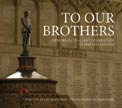|
TO OUR BROTHERS
Memorials to a Lost Generation in British Schools
Written by Sarah Wearne and photography by James Kerr
|
 This beautifully produced book is timely, since it comes in the aftermath of the First World War commemorations, just at the time, 100 years ago, when the nation was beginning to think about how all those individual sacrifices were to be remembered. The servicemen who were killed or died overseas were buried near where they fell, and of course there were many who had no known grave. In time, towns and villages raised memorials to those who did not return, as did many factories, railway stations, hospitals, clubs and other institutions, including schools and universities. Their names were of course recorded in cemeteries and memorials on the battlefields, but it was important that something was done at home as well. Unlike the strict conventions in style and design adopted by the Imperial War Graves Commission, these memorials are all quite different; each one is unique. This beautifully produced book is timely, since it comes in the aftermath of the First World War commemorations, just at the time, 100 years ago, when the nation was beginning to think about how all those individual sacrifices were to be remembered. The servicemen who were killed or died overseas were buried near where they fell, and of course there were many who had no known grave. In time, towns and villages raised memorials to those who did not return, as did many factories, railway stations, hospitals, clubs and other institutions, including schools and universities. Their names were of course recorded in cemeteries and memorials on the battlefields, but it was important that something was done at home as well. Unlike the strict conventions in style and design adopted by the Imperial War Graves Commission, these memorials are all quite different; each one is unique.
All memorials are poignant, however there is something so personal about a school memorial. Young men killed perhaps just a few months after leaving the school, with those in their last term knowing that they will be next into the cannon’s roar. One is reminded, as were the authors of this book, by the sad scenes in Goodbye Mr Chips, when the names of those killed while serving at the front are read out by a master in the school chapel. For Chips, who had been at the school for a long time, it was much more painful than for the much younger master. ‘They are only names to him; he doesn’t see the faces as I do’.
Books about cemeteries and memorials can sometimes have an element of sameness about them, but that could not be said about this book, with its well-written and informative text, and beautiful photographs. 50 schools are covered here, and the memorials are all quite different. There are books of remembrance and rolls of honour, all bearing names, but each is designed in its own way, sometimes in wood, or bronze, or brass, or carved on stone, or engraved on glass, and surrounded by unique designs. There are also statues, memorial buildings and cloisters, wooden crosses, and sometimes more abstract objects or pictures that convey a collective remembrance. Money was a challenge for some schools, reflected by the scale and scope of their memorials, and also by what the staff and students actually wanted. Opinions differed in some schools: was the memorial to be of practical use, like for example a new assembly hall or similar; or was it to be just a memorial. The varied beauty of these memorials is impressive, as is the extent to which schools went to engage fine craftsmen and well-known artists: Gilbert Ledward, Sir Giles Gilbert-Scott, and Eric Gill, to name just three.
As Sarah Weane explains in her introduction, the imagery, language and iconography of these memorials is not one that is easily understood by later generations. There was nothing avant garde about these memorials. Nor was there room for modern art or sculpture. They were, above all, traditional, Christian in their denomination, and heroic in their style. In the main, they evoke much more of Henry Newbolt and ‘Play up, play up, and play the game’ than Wilfred Owen and ‘Anthem For Doomed Youth’, with all the ghastly reality conveyed in that poem.
James Kerr’s photography is superb. Every picture is thoughtfully composed and atmospheric, capturing the uniqueness and poignancy of these memorials. Also, unlike the memorials in churches and public places, these ones are not often seen beyond the confines of the school and its alumni. There are some unknown and unseen treasures here, even a few that the schools themselves did not know about.
This is a wonderful book. It is only sad that one or two schools, notably Harrow School, did not allow access to the authors. A shame, but this does not undermine or spoil the book at all.
The Editor
Published by Helion and Company
www.helion.co.uk
|
|